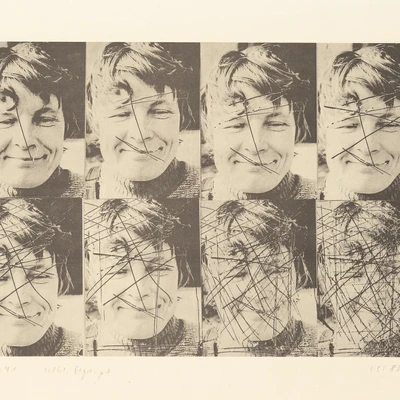Werner Tübke
- * 1929
- † 2004
Life dates
- Artist
Category
A Stranger among Strangers
Werner Tübke drew himself in 1984 as a haggard, cerebral, proud, knowledgeable, but also insecure man. Ten years earlier, full of curiosity, he had ridden on horseback through the Caucasus, a fascinating, foreign world. There, too, he had drawn a self-portrait, portraying himself as a lone equestrian in the solitude of the mountains – as he had once before, in 1961, when he travelled for an entire year through the Soviet Union, including the Caucasus. Decades later, he still recalled this journey with enthusiasm, writing in 1995 to the art historian Eduard Beaucamp, for instance: “Meeting Russian people in their villages in Russia, in the Causcasus, in Central Asia, and on the border to China had a powerful impact on me. The longing to travel far away, the feeling of having no real home, the search for God, poverty, blackest evil, firm family ties over generations, a lofty Eurasian cultivation and the most natural fluency in foreign languages – they are really something.”
By the time of that first journey in 1961, Werner Tübke already had some turbulent years behind him. Born 1929 into a businessman’s family, he had had the benefit of private drawing lessons starting in 1940. In 1945/46, he was imprisoned for several months on grounds of an unfounded suspicion that he had executed an attack on Soviet soldiers. Thereafter, he studied painting in Leipzig and art education in Greifswald. In 1956/57 he was hired as a senior research assistant at the Hochschule für Grafik und Buchkunst in Leipzig, but was dismissed from his post for political-artistic reasons. Reinstated in 1961, Tübke soon drew a lot of attention to himself with large-format paintings. Full of metaphors and references to history, in a style informed by his study of Italian Renaissance painting and recalling the old masters, Tübke’s art was often criticized by the GDR authorities – especially because they found it difficult to coopt him politically – but it enjoyed considerable success abroad. Thus Werner Tübke became one of the first artists from the GDR who was permitted to exhibit at the Documenta in Kassel.
Tübke’s pictorial narratives from this period – often packed with figures and evoking magic surrealism, as in his Folterszene (Torture Scene) from 1976 – already point in the direction of later works such as the overwhelming panorama painting on the Frühbürgerlichen Revolution in Deutschland (The Proto-Bourgeois Revolution in Germany) in memory of the 1525 Battle of Frankenhausen in the German Peasants’ War. Tübke and his assistants worked from 1979 to 1987 on this work, which spanned 14 by 123 meters and included circa 3000 figures, including the painter himself in the form of a harlequin. Later, in 1989, Tübke wrote in his Erinnerungen an Bad Frankenhausen (Memories of Bad Frankenhausen): “I should like to call it a deeply democratic stance of the artist: He should always stand on the side of those who are oppressed, left behind, abandoned, and imprisoned; those who are physically or emotionally ill; those who are persecuted, harassed, lonely, tired, hungry, poor, and tortured … all over the world, there is so much misery and want, so much despair at the prospects of earning a living or finding any meaning in life – and this includes, as we have always known, the people living between Brest and Vladivostok, between Novaya Zemlya and Samarkand … Our work should be to speak of the suffering of life, to give enduring visual form to the fates of human beings.”
This affinity with those damned among mortals is not always evident in his art – one could even say he kept his distance from them. For all his rejection of Modernism, for all his admiration of figurative, representational art in the tradition of the old masters, Tübke kept his distance from the life made of blood, sweat, and tears. It is as though he painted not for the people on whose side he wished to stand, but for himself, and for an elite on whose side he knew he stood in fact – an elite whose praise and criticism was all too important to him. Thus Werner Tübke remained a stranger among strangers, a brilliant painter inhabiting an aristocratic island in the self-styled nation of workers and farmers called the GDR. He himself reflected on this in, among other works, the painting Der alte Narr ist tot (The Old Fool is Dead).
Werner Tübke died on 27 May 2004 in Leipzig.
text: Matthias Zwarg, translation: Darrell Wilkins
Works by Werner Tübke
Travelling exhibition
Publik machen: 40 Künstler:innen aus dem Bestand des Zentrums für Kunstausstellungen der DDR
Popular keywords
Many more works are hidden behind these terms
